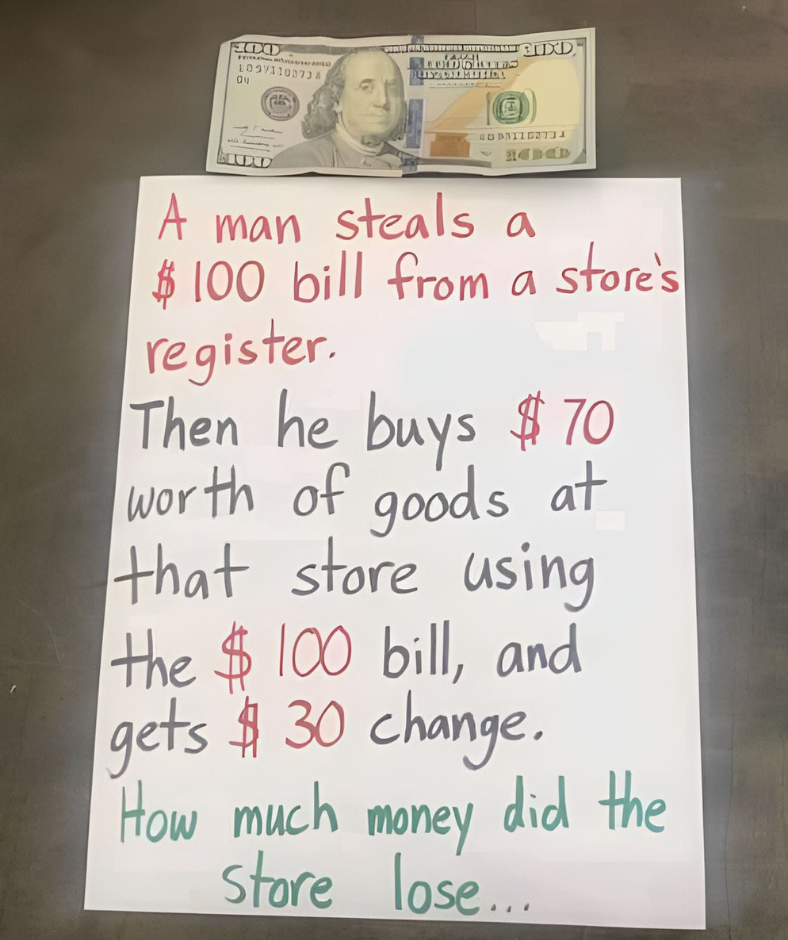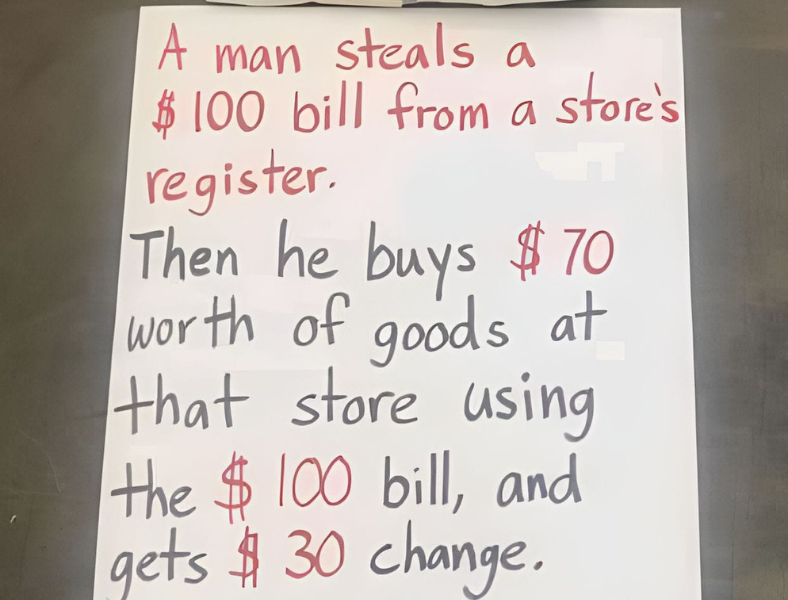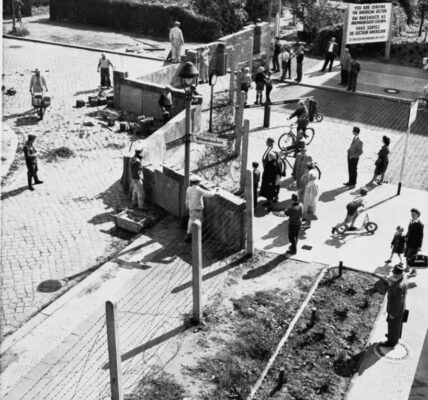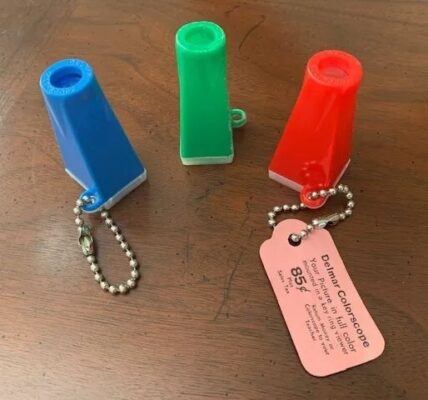In today’s social media-driven world, brain teasers are taking over as a popular form of entertainment and intellectual challenge. Recently, a math riddle went viral, gaining over 50.1 million views on X (formerly Twitter), and leaving millions scratching their heads. The riddle? A man steals a $100 bill, buys $70 worth of goods with it, and receives $30 in change. The question posed is, “How much did the store lose?”

Let’s break down this intriguing puzzle, analyze the different perspectives, and finally uncover the correct answer. It’s time to see what really happened to the store’s finances.
The Riddle Breakdown: Understanding the Scenario
To solve this puzzle, it’s essential to analyze each step of the transaction. The man stole $100, purchased goods worth $70, and walked away with $30 in change. At first glance, the answer might seem simple, but when you delve into the details, things get more complicated. Here’s a step-by-step look:
Step 1: The Theft
The man starts by stealing a $100 bill from the store’s cash register. At this point, the store has already lost $100. The man has that stolen bill in hand, and the store’s total loss is $100.
Step 2: The Purchase of Goods
Next, the man spends the same $100 bill he stole to buy $70 worth of merchandise. He hands the $100 bill back to the cashier. While this momentarily seems like the store has regained its $100, they’ve now lost $70 in goods. Thus, we can say that the store’s total financial loss now includes the $70 worth of products taken by the man.
Step 3: The Change Given Back
Finally, the store gives the man $30 in change for his “purchase.” This further reduces the store’s cash by $30. So, the store has now lost both the $70 in goods and an additional $30 in cash.
By adding up these transactions, the answer may appear clearer. But let’s explore this further by analyzing the overall impact of each step.
Adding Up the Losses: A Step-by-Step Calculation
How the Store’s Loss Accumulates
- The Stolen $100 Bill – The store loses $100 initially.
- $70 in Goods – The store provides $70 worth of merchandise, which is now in the man’s possession.
- $30 in Change – The store gives $30 in cash back to the man.
Now, we total these losses. The stolen $100 represents the initial loss, which is offset when the man returns it to the register. However, the $70 in goods and the $30 in change are real, unrecoverable losses. Combined, these add up to $100.
Therefore, the store’s final net loss is $100, derived from $70 worth of goods and $30 in change.
Exploring Different Interpretations: Why the Answer Isn’t So Simple
You may wonder why so many people came up with different answers to this puzzle. The reason lies in how each person interprets the transactions. Some people calculate based on the initial $100 theft alone, while others consider the goods and change separately. Here are a few of the different interpretations that have surfaced online:
- Interpretation One: Some say the store lost only $30 in cash, as they believe the $100 was regained during the purchase.
- Interpretation Two: Others add the stolen $100 to the $30 change, saying the loss totals $130.
- Interpretation Three: Finally, a group calculates the loss by combining the stolen cash, the goods, and the change, correctly arriving at $100.
In truth, the most accurate approach considers both the merchandise and the cash given as change. This ensures that the full scope of the store’s loss is accounted for.
The Correct Answer: Why the Store Lost $100
I’m still trying to work out the answer…🤔 pic.twitter.com/ZMgkMBmGoH
— Out of Context Human Race (@NoContextHumans) September 23, 2023
To put this riddle to rest, we must recognize that the store’s total loss comes from the goods and the change given to the man. Here’s how it breaks down:
- The Goods ($70) – Once the man walks out with the merchandise, the store can’t recover this amount. It’s a tangible loss.
- The Change ($30) – The cash handed to the man is gone for good as well, adding to the store’s financial loss.
Combined, these elements total $100. The initial theft of the $100 bill does not add further to the loss, as the stolen bill was effectively returned when the man used it to pay for his purchase. Instead, the real losses stem from the merchandise and change.
Lessons from the Riddle: Why Details and Context Matter
This riddle isn’t just a clever brain teaser; it highlights important lessons about problem-solving and critical thinking. Here’s what we can take away from this viral sensation:
1. Attention to Detail is Key
In puzzles like this, the answer often lies in the details. The initial $100 theft distracts us from the true nature of the loss, which includes both goods and cash given as change. By focusing on the finer points of each transaction, we arrive at a more accurate conclusion.
2. Context Shapes Interpretation
As we’ve seen, people can interpret scenarios in different ways, depending on their focus. By understanding the context of the riddle—where both goods and change count as losses—we can make a more precise assessment. In real-world situations, context is just as critical, helping us evaluate outcomes more thoroughly.
3. The Importance of Problem-Solving Skills
Riddles like this are not only entertaining but also sharpen our problem-solving skills. They encourage us to think critically, consider multiple perspectives, and analyze situations in depth. This kind of thinking is beneficial in everyday decision-making, from managing finances to navigating complex social interactions.
Conclusion: The Final Verdict on the Store’s Loss
In conclusion, the store’s net loss in the $100 brain teaser amounts to $100. The man walked away with $70 worth of goods and $30 in cash, representing the total financial hit to the store. This viral riddle not only challenges us to think critically but also reminds us of the importance of attention to detail, context, and perspective.
So, next time you come across a tricky brain teaser, remember the lessons learned from this one. Take a moment to analyze each part, question your assumptions, and look beyond the obvious. Who knows—you may just discover that the solution is simpler than it seems, once you peel back the layers of complexity.




